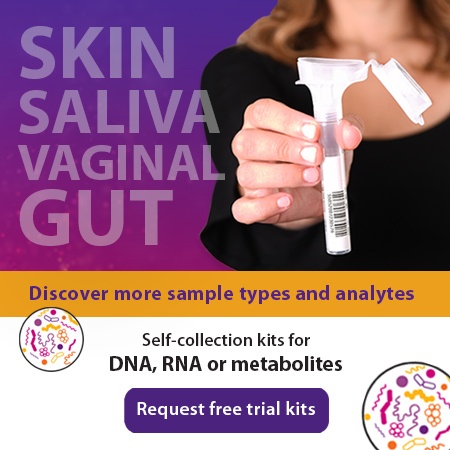2018-08-09
Those of us following microbiome science know that it is developing extremely fast with tremendous opportunity for innovation. When we were presented the opportunity to participate in the recent webcast titled ‘Advances in Microbiome Discovery, Diagnostics and Therapeutics’ hosted by Nature.com, we were thrilled to agree. In this webinar, DNA Genotek and a panel of experts discussed their perspectives on advances in microbiome discovery. This webinar is available in its entirety on-demand (here), but knowing how time-pressed we all are, we have provided a summary for you below.
DNA Genotek’s own Dr. Lisa Gamwell, Ph.D. (Microbiome Product Manager) presented "The importance of microbial sample quality and the impact it can have on your ability to answer your research questions of interest.”
You probably know that DNA Genotek is focused on biospecimen collection and stabilization devices servicing two main markets: human genomics and microbiome. Microbiome research is at an interesting juncture transitioning from novelty proof-of-concept research to reproducible and rigorous utility research.
In Dr. Gamwell’s presentation, she used a succinct Bray-Curtis plot to characterize the sources and extent of variability in microbiome workflow from fecal sample collection to next-generation sequencing (NGS). She explained that through the analysis of technical replicates, there is little variability introduced by the sequencing or the extraction method, provided the protocol remains consistent. If the extraction method used changes across samples, this will introduce a significant amount of variability into your study. Extraction methods should always be controlled when comparing cohorts that used different extraction kits. Another significant source of variability is the use of improper sample stabilization methods, introducing variability sometimes exceeding the inter-donor variation.
She commented: “This level of noise would dramatically impair an investigator’s ability to find associations between gut microbes and phenotypes of interest…if you use an optimal stabilization method, choose something validated and shown to be unbiased and stable over real-world time and temperature exposures, then the variability in the sample collection step of your workflow is reduced to technical variability inherent in the overall workflow”.
In a meta-analysis comparing a number of stabilization methods, including homebrew, freezing, and OMNIgene®•GUT, she highlighted that fecal samples collected with OMNIgene•GUT showed very little variability. She added that the collection method is user-friendly for naïve users, making it an excellent choice.
When Dr. Gamwell was asked what do differences in variability and sample collection methods mean to a researcher, she focused on the importance of validated stabilization methods, such as that offered by OMNIgene•GUT, to the operational and financial impact of studies.
“At the core of what we do is discovery. We hope to facilitate a discovery of something like a ‘druggable’ target, a profile that’s associated with health or disease, or a bacterial candidate that can impart a benefit to someone. We all want to conduct this expensive research as efficiently as possible and within our budgets.” Human research studies often fail for a couple reasons, either the science doesn’t support the hypothesis or they fail to produce statistically significant results. The latter reason can happen when sources of technical variability are not considered and a study is underpowered. Study power can be increased by increasing the number of subjects, which can skyrocket study costs, or by opting to use validated stabilization methods, such as OMNIgene•GUT that reduce technical variability. “Validated stabilization methods make operational and financial sense.”
Furthermore, this study highlights the importance of reducing technical variability and noise in microbiome analysis so that you’re sure the correlations you’re discovering are in fact not just measurements of the technical variability. So it’s really important to ensure your methods are as good as they can be by using validated standardization methods for microbiome sample collection.
If you would like to try the OMNIgene•GUT kits referenced by Dr. Gamwell in this webinar for your own evaluation, you can request samples below.
OMNIgene•GUT (OMR-200) is for Research Use Only (RUO) in the United States.


